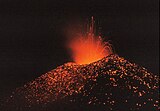|
Volcán de Agua
Volcán de Agua (also known as Junajpú by Maya) is an extinct stratovolcano located in the departments of Sacatepéquez and Escuintla in Guatemala. At 3,760 m (12,340 ft), Agua Volcano towers more than 3,500 m (11,500 ft) above the Pacific coastal plain to the south and 2,000 m (6,600 ft) above the Guatemalan Highlands to the north. It dominates the local landscape except when hidden by cloud cover. The volcano is within 5 to 10 km (3.1 to 6.2 mi) of the city of Antigua Guatemala and several other large towns situated on its northern apron. These towns have a combined population of nearly 100,000. It is within about 20 km (12 mi) of Escuintla (population, c. 150,000) to the south.[2] Coffee is grown on the volcano's lower slopes. Brief description and history The local Kaqchikel people have always called the volcano Hunapú "place of flowers" or Jun Ajpu' "one hunter" (The calendar date for the sacred site; a typical method for naming sacred sites in Mayan cosmovision) in current Kaqchikel orthography.[citation needed] The Spanish conquistadors also called it Hunapú until a lahar from the volcano on September 10, 1541[4] destroyed the original capital of Guatemala (now known as Ciudad Vieja) and the city was moved to Antigua Guatemala following this disaster. Among the casualties was the governor Beatriz de la Cueva.[5] As the lahar produced a destructive flood of water, this prompted the modern name "Volcán de Agua" meaning "Volcano of Water", in contrast to the nearby "Volcán de Fuego" or "Volcano of Fire". The Kaqchikels call Volcán de Fuego Chi Gag, which translates to "where the fire is" or Chi Q'aq' in current Kaqchikel orthography. The volcano was active in the late Pleistocene between 80,000 and 10,000 years ago,[2] but has not erupted since then.[1] Despite the lack of eruptive activity, the volcano can still produce debris flows and lahars that inundate nearby populated areas.[2] This was proven by the fact that on 11 September 1541, newly founded villa of Santiago de los Caballeros was ruined by a "formidable landslide that came down Volcán de Agua; the mudslide brought along heavy rocks that destroyed part of the buildings and damaged the rest".[6] The city was destroyed and the survivors had no direction, since governor Beatriz de la Cueva died during the disaster, which took place shortly after her husband, Adelantado Pedro de Alvarado, died and she was appointed governor by the Ayuntamiento (English:City Hall).[7] Beatriz de la Cueva had been beside herself with grief and on 9 September 1541, when she had signed the Cabildo documents, she did so as "la sin ventura" (English: the unlucky one), a phrase that turned out to be prophetic.[8] In the aftermath Beatriz de la Cueva was blamed for the disaster as it was considered to be a godly punishment for her sins. Additionally her fate became a cautionary tale about giving women positions in government particularly when many qualified men were available.[9]  In 1895 Anne Cary Maudslay and her husband, archeologist Alfred Percival Maudslay visited the Antigua Guatemala region as part of a journey through Guatemala's Maya and colonial archeological monuments, and climbed the Volcán de Agua; she wrote a book called A Glimpse at Guatemala where she explains that water from the volcano crater could not have destroyed the old Santiago:
The volcano was last blanketed by snowfall in January 1967.[citation needed] The Volcán de Agua has been declared a protected area in 1956 and covers an area of 12,600 hectares (31,000 acres).[11] On 21 January 2012, 12,000 Guatemalans formed a human chain all the way to the peak of Volcán de Agua in a protest against domestic violence.[12] Gallery
See also
Notes and referencesReferences
Bibliography
External links
|
||||||||||||||||||||||||||||
Portal di Ensiklopedia Dunia







